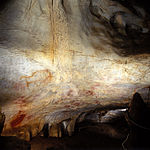Cantabria (, also UK: , Spanish: [kanˈtaβɾja] ) is an autonomous community and province in northern Spain with Santander as its capital city. It is called a comunidad histórica, a historic community, in its current Statute of Autonomy. It is bordered on the east by the Basque autonomous community (province of Biscay), on the south by Castile and León (provinces of León, Palencia and Burgos), on the west by the Principality of Asturias, and on the north by the Cantabrian Sea (Bay of Biscay).
Cantabria belongs to Green Spain, the name given to the strip of land between the Bay of Biscay and the Cantabrian Mountains, so called because of its particularly lush vegetation, due to the wet and temperate oceanic climate. The climate is strongly influenced by Atlantic Ocean winds trapped by the mountains; the average annual precipitation is about 1,200 mm (47 inches).
Cantabria has archaeological sites from the Upper Paleolithic period, although the first signs of human occupation date from the Lower Paleolithic. The most significant site for cave paintings is in the cave of Altamira, dating from about 37,000 BCE and declared, along with nine other Cantabrian caves, as World Heritage Sites by UNESCO. Historically, the territory sits in the area of Cantabria in the ancient period, but from the Late Middle Ages to the early 19th century, the name Cantabria also referred to the territory of the Basques, especially the lordship of Biscay.The modern Province of Cantabria was constituted on 28 July 1778 at Puente San Miguel, Reocín. The yearly Day of the Institutions holiday on 28 July celebrates this. The Organic Law of the Autonomy Statute of Cantabria, approved on 30 December 1981, gave the region its own institutions of self-government.








